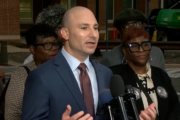With hurricane season predicted to be more active than usual, homeowners should make necessary home preparations as storm season picks up steam. The National Oceanic and Atmospheric Administration’s National Hurricane Center estimates between 17 to 25 named storms in the Atlantic this year due to warmer weather and La Niña. 2024’s second named tropical storm, Beryl, made landfall July 1 on Grenada’s Carriacou Island in the Caribbean Sea with maximum sustained winds of 150 mph. The storm triggered power outages and flooded streets in parts of the Grenadines, Grenada, Barbados and Tobago, according to the National Hurricane Center.
Storm preparations can include a well-equipped hurricane kit, backup generator or installing impact windows. These windows eliminate the need for hurricane shutters and add a layer of protection from pressurization if a window is broken. However, not all homeowners can spend tens of thousands of dollars replacing windows or other openings. That’s where hurricane shutters come in.
Hurricane shutters can be installed over existing windows, adding the necessary protection from debris and wind pressure. However, picking the right hurricane shutters to protect your home’s openings can be overwhelming. “The only thing worse than having no protection from a hurricane is having the wrong kind,” says Leslie Chapman-Henderson, president and CEO of the nonprofit Federal Alliance for Safe Homes in Tallahassee, Florida.
There are many different hurricane shutter options, from permanent to temporary solutions.
[What Homebuyers Need to Know About Climate Change]
Do You Need Hurricane Shutters?
Flooding and storm surges cause the most damage to property and risk to life during a hurricane. However, new data from the Massachusetts Institute of Technology shows that wind loads on homes are more severe than previously believed. The American Society of Civil Engineers concluded, by failing to account for neighborhood texture — the density and configuration of surrounding buildings — traditional wind loss models underestimate expected wind-related losses and undervalue wind mitigation.
When storm winds are strong, windows and other openings can be penetrated with flying debris. This causes storm pressure to build inside your home and can cause your roof to rip off. “It’s like a balloon popping,” says Chapman-Henderson. “That’s why it’s critical to protect your openings.”
Plywood is a temporary solution, but it isn’t foolproof. Wood can warp when it gets wet, requiring you to replace it the following season.
[How Climate Change Could Impact Your Home Value]
Hurricane Shutter Options
There are three key considerations when choosing hurricane shutters for your home: budget, aesthetics and whether you want a permanent or temporary solution. Temporary hurricane shutters aren’t as much of an eyesore year-round. Some permanent shutters are more aesthetically pleasing than others, but many more affordable permanent options have less attractive curb appeal.
On the flip side, temporary shutters require you to drill or attach the shutters on each opening before the storm, which can be cumbersome for homeowners who aren’t physically able to do so or need to install shutters in hard-to-reach places. Also, you’ll need a place to store them when they’re not in use. This could be a shed or garage, but for homeowners with limited space, temporary shutters can be less appealing.
There are three main materials used for shutters:
— Aluminum
— Steel
— Polycarbonate (plastic)
[6 Easy Ways to Make Your Home Eco-Friendly]
Hurricane Fabric
AstroGuard hurricane fabric, a high-strength nylon hybrid fabric with UV resistant resin coating, is a new, patented option. It’s lightweight and easy to put up and to store.
Fabric should be measured to cover all windows, adding a few extra inches to affix the brackets to the wall. The brackets stay on your home year-round, and when a storm comes you attach the fabric to the brackets to cover the openings. The product is durable and lightweight, which makes it the best option for homeowners with limited storage space.
It’s not a cheap solution, however. Prices will range between $100 for a 44-inch x 72-inch opening to $550 for a 100-inch x 208-inch opening. If you have multiple windows you need to protect, this could cost several thousand dollars.
Pros of Hurricane Fabric
— Lightweight
— Can be stored easily due to its material and weight
— Category 5 wind load tested
Cons of Hurricane Fabric
— Brackets are permanently affixed, which impacts curb appeal
— Can be tricky to install without help
— Mid-tier pricing costs several hundred to thousands of dollars
Hurricane Panels
“Panels are the cheapest option. They are a better choice compared to plywood, but still require you to install them before the storm and store them somewhere,” says Frank Madonia, vice president of sales for Storm Smart, a storm protection manufacturer, fabricator and installer in Fort Myers, Florida.
Panels can come in aluminum, polycarbonate or steel, but polycarbonate is the most affordable choice. Polycarbonate is a clear plastic, so you can see what is happening outside during the storm. The panels should be cut to the size of your window or door and can be attached to nuts on the side of your home. You can have them permanently installed using a track that it slides into, however, the track can be an eyesore.
They are also the most affordable option, costing around $12 to $15 per linear foot. For a 48-inch x 72-inch opening, that’s roughly $78.
Pros of Hurricane Panels
— Come in several materials, including a clear plastic to see what is happening outside
— Affordable, can be less than $100 per window
Cons of Hurricane Panels
— Require you to install them before the storm
— Need to be stored somewhere
Accordion Shutters
“Accordion shutters have a bottom and top track around the window or door,” where you pull the shutters together and secure them with a lock, Madonia says. There are also aluminum or roll-down screen shutters, which work similarly to accordion shutters. “They move up and down, staying in a box or hood at the top when not in use. Both are less pleasing because you have to step over the track or it’s permanently on your home,” says Madonia.
Accordion shutters are a good option for homeowners who want a permanent solution, aren’t as preoccupied with aesthetics and might have a lower budget. They also can be installed in large spaces, such as in front of a sliding glass door. Price ranges will vary per opening, but expect to spend around $200-$250 per window for accordion shutters without installation.
Pros of Accordion or Roll-down Shutters
— Can be permanently affixed so no pre-storm installation is necessary
— Easy to protect your home before a storm
Cons of Accordion or Roll-down Shutters
— Mid-tier pricing
— Can be cumbersome or unattractive
Colonial Shutters
Colonial shutters are one of the more aesthetically pleasing permanent hurricane shutter solutions. Not only are they functional but, as Madonia puts it, “They can actually add to the look of the home.” Many older homes already have colonial-style shutters that are permanently attached and cannot protect openings during a hurricane.
In the case of hurricane-rated colonial shutters, “they retract and fold in across the window and you lock them with a bar. You can lock them from the inside or outside,” says Madonia. The shutters have louvers that can open or close to let air flow through if closed and are made to withstand Category 5 winds. They are one of the more expensive options.
Large window openings are one challenge with this type of hurricane shutter. They can stack on top of themselves to appear like a single-panel shutter, but truly unfold into a two- or three-panel covering. Very large openings may be better suited to an alternative solution. Additionally, you may not have sufficient wall space to the left or right of the window to have a Colonial shutter mounted.
Impact-rated colonial shutters are fairly affordable around $45 to $75 per panel.
Pros of Colonial Shutters
— Aesthetically pleasing with functionality
— A permanent solution that can be secured quickly
— No bulky tracking system and does not block views
Cons of Colonial Shutters
— One of the more expensive shutter solutions
— May not work for all windows
— May not fit the style of your home
Bahama Shutters
Bahama shutters have been used for centuries in the Carribean Islands to protect properties from storms. The metal shutters are permanently affixed to a window with a specialized louver system. “It shades the top of your window at a 45% fixed angle,” which limits your view, Madonia says, but it offers privacy. You can open and close the shutters using a telescopic arm, making it easy to protect your windows when a storm is on the way.
“The Bahama louvers are designed for optimal breeze and block direct sunlight,” he says. This can be nice if you don’t have energy-efficient windows that reduce UV damage and help lower your electricity bill. However, the semi-obstructed view can be a deal-breaker for some homeowners. When you look out your window you will see the louvers, not your backyard or front yard. Bahama shutters are a little more expensive than Colonial, costing anywhere from $140-$340 per window. However, their prices aren’t too far off from accordion shutters.
Pros of Bahama Shutters
— Aesthetically pleasing, providing a Caribbean look to your home
— A permanent solution that can be secured quickly
— Energy efficient by blocking light but optimizing breeze while adding privacy
Cons of Bahama Shutters
— Cannot be opened at more than 45% angle, blocking your view to the outside
— Limits light in your home
— One of the most expensive shutter options
Most hurricane shutters can be installed on homes with 10 to 15 openings for less than $5,000. However, the size of your windows, shape and available space will impact costs. Owners of homes with lots of windows or several super large openings should be prepared to spend $5,000 to $10,000 to properly protect their home.
More from U.S. News
Can You Build a Hurricane-Proof House?
Are Impact Windows Worth the Cost?
How Climate Change Could Impact Your Home Value
What Hurricane Shutters Are Best for Your Home? originally appeared on usnews.com







